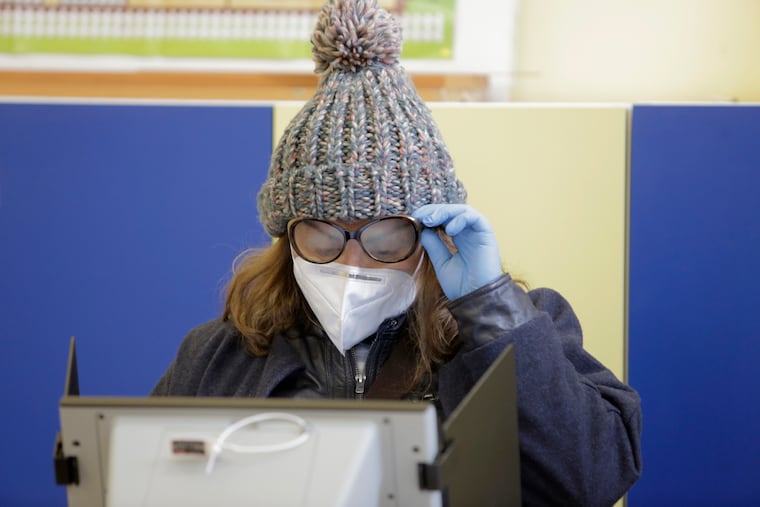Why your mask may be causing eye problems
Whatever you do, keep wearing your mask. Eye problems are easier to address than a case of COVID-19, doctors agree.

As millions who wear glasses can attest, the exhaled breath escaping from the top of a poor-fitting mask can cause your lenses to fog up.
For months now, eye doctors have suspected that this upward flow of air also may lead to problems in the eye itself, including dryness and the reddish bumps called styes.
The evidence for this phenomenon is indirect, and these issues should by no means prompt anyone to stop wearing masks, ophthalmologists say. The solution is simply to make sure the mask is clean and that it fits properly, whether by tightening the straps or pinching the metal band on the top so it hugs the nose.
And should someone develop a stye, caused by a blocked oil gland in the eyelid, it is easily treatable, said Jurij Bilyk, a Wills Eye Hospital eye surgeon.
“This is no excuse not to wear a mask,” he said. “These issues are much more minor than getting COVID.”
» READ MORE: Delco hospitals are full and an ER is closing as COVID-19 surge intensifies in Philly area
Eye doctors started to see an increase in styes in mid-2020, in the first year of the pandemic. Among those who thought masks might be a factor was Shoaib Ugradar, an ophthalmologist at UCLA’s Stein Eye Institute. To make sure it wasn’t some sort of seasonal or Los Angeles-specific phenomenon, he collaborated with Rona Silkiss, an eye surgeon at California Pacific Medical Center, in San Francisco, to track cases over time.
For several months in 2020, both centers identified an increase in patients with chalazion, a type of stye, relative to the corresponding months in previous years. The increase at the Los Angeles center occurred in April and May before receding to normal levels, while the San Francisco bump took place in June through August (the last month that was tracked), the doctors reported in the American Journal of Ophthalmology Case Reports.
They did not measure mask usage, but theorized that the face coverings could be contributing to the chalazion increase in several ways. The upward flow of exhaled air might be drying out the eye, leading to a blockage in the oil glands. Or the culprit might be bacteria in the person’s breath.
“It’s kind of like having a fan blowing on your eyes,” Ugradar said in a phone interview. “It dries out your tears. It changes the microenvironment around your eyes.”
Yet another possibility is that when adjusting their masks, people were touching their face with unclean fingers, he and Silkiss wrote.
To explore the bacteria-in-breath theory further, one of Bilyk’s Wills Eye colleagues, Samir Patel, led an unusual experiment: attaching plates of growth medium to the foreheads of 15 volunteers.
» READ MORE: Pfizer plans to manufacture up to 100 million doses of an omicron-specific vaccine by the spring
Researchers measured the growth bacteria on the plates when the participants wore various types of masks. Bacteria growth was higher on the foreheads of those wearing surgical masks, compared with those wearing N95 masks — though this difference disappeared when the upper edge of the surgical mask was secured with adhesive tape.
The use of cloth masks also was associated with higher bacteria counts than when wearing N95 masks, but only when the volunteers were speaking, Patel and his co-authors reported in the American Journal of Ophthalmology.
Ugradar, the UCLA physician, said it is likely that several factors have contributed to the increase in styes. Among them, he said, could be another phenomenon of the pandemic: stress.
“It’s not one explanation that explains everything,” he said.
» READ MORE: ‘Flurona’ is real, but don’t panic — it’s common to get two viruses at once
In addition to wearing a clean, snug-fitting mask, another way to prevent styes might be to use mouthwash to minimize bacteria in the mouth, he said.
To the extent that dry eye might be contributing to blocked oil glands, still another option is to use “artificial tears” eye drops, said Bilyk, a professor of ophthalmology at Thomas Jefferson University.
But for those who develop styes, the condition is easily treatable, he said. An eye doctor may recommend warm compresses to help drain the blocked gland. Certain ointments also can help.
If the gland becomes infected, a doctor may prescribe an oral antibiotic, Bilyk said. If all else fails, the doctor may make a small incision and drain the blockage.
“If you develop a stye, there’s no reason to panic,” he said. “We can take care of it.”